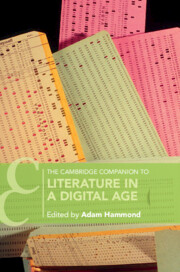Book contents
- The Cambridge Companion to Literature in a Digital Age
- The Cambridge Companion to Literature in a Digital Age
- Copyright page
- Contents
- Figures
- Contributors
- Chronology
- Introduction
- Chapter 1 Literary Data
- Chapter 2 Literary Change
- Chapter 3 The Canon
- Chapter 4 Voice and Performance
- Chapter 5 The Archive
- Chapter 6 Editions
- Chapter 7 Materiality
- Chapter 8 The Literary Marketplace
- Chapter 9 Fanfiction, Digital Platforms, and Social Reading
- Chapter 10 Narrative and Interactivity
- Chapter 11 Generated Literature
- Chapter 12 Literary Gaming
- Chapter 13 The Printed Book in the Digital Age
- Chapter 14 Literature’s Audioptic Platform
- Chapter 15 Critique
- Index
- Cambridge Companions To Literature
Chapter 14 - Literature’s Audioptic Platform
Published online by Cambridge University Press: 29 November 2024
- The Cambridge Companion to Literature in a Digital Age
- The Cambridge Companion to Literature in a Digital Age
- Copyright page
- Contents
- Figures
- Contributors
- Chronology
- Introduction
- Chapter 1 Literary Data
- Chapter 2 Literary Change
- Chapter 3 The Canon
- Chapter 4 Voice and Performance
- Chapter 5 The Archive
- Chapter 6 Editions
- Chapter 7 Materiality
- Chapter 8 The Literary Marketplace
- Chapter 9 Fanfiction, Digital Platforms, and Social Reading
- Chapter 10 Narrative and Interactivity
- Chapter 11 Generated Literature
- Chapter 12 Literary Gaming
- Chapter 13 The Printed Book in the Digital Age
- Chapter 14 Literature’s Audioptic Platform
- Chapter 15 Critique
- Index
- Cambridge Companions To Literature
Summary
In moving to align narrative envisioning with the likes of CGI (computer-generated images) or laser holograms, this chapter sets out to rethink the essential text/image relation in literary reading under the generative rubric of IMAGEdTEXT: the visualization made operational, just as it sounds in that compound, by the alphabetic (and thus phonetic) momentum of written speech. This is the forward motion, at times momentarily recursive, by which mental images are produced, vistas made available, narrative scenes set and peopled, events brought to mind. It is in this sense that Western literature, rooted in what linguists call the “graphophomemic” structure of sound–symbol relations, summons sights and sounds from the spinning gears of what is at base an audiovisual engine of its own – one that, in just such a phrase, may set ringing ears spinning, dizzy with unseen wording as well as new mental pictures. Authors from George Eliot through Henry James, Proust to Richard Powers, are read into evidence on the score of such textual “audioptics.”
- Type
- Chapter
- Information
- The Cambridge Companion to Literature in a Digital Age , pp. 250 - 272Publisher: Cambridge University PressPrint publication year: 2024

